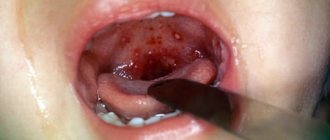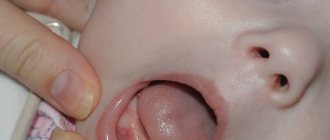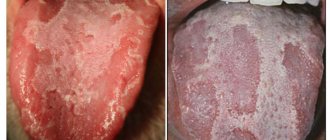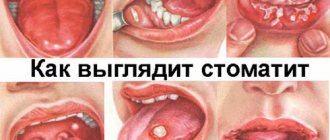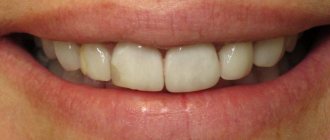Causes of plaque
It is important to know!
EVERYONE should know about this! UNBELIEVABLE BUT TRUE! Scientists have discovered a SCARY relationship. It turns out that the cause of 50% of all ARVI diseases, accompanied by elevated temperature, as well as symptoms of fever and chills, are BACTERIA and PARASITES, such as Giardia, Ascaris and Toxocara. How dangerous are these parasites? They can deprive health and EVEN LIFE, because they directly affect the immune system, causing irreparable harm. In 95% of cases, the immune system is powerless against bacteria, and diseases will not be long in coming.
To forget about parasites once and for all, while maintaining your health, experts and scientists advise taking.....
.. »
Most often, a white coating in the patient’s throat appears on the tonsils. The mechanism of its appearance is that when pathogenic microbes come into contact with the mucous membranes, immunity is triggered.
The body's defenses respond to the threat and neutralize the attack of microbes, resulting in a plaque on the throat.
It is necessary to promptly establish the causes of the infection for appropriate treatment in order to prevent its further penetration into the respiratory tract, bronchi and lungs.
White spots often appear in the recessed area of the tonsils. This is facilitated by the smallest particles of food, which decompose, forming suppuration, under the influence of rapidly multiplying pathogenic microbes. The whitish spots that form on the surface of the tonsils resemble a cheesy mass, which can be easily removed with a cotton swab. The reason for its formation is the waste product of pathogenic fungi that cause mycoses of the larynx. Spots on the back wall of the pharynx indicate the occurrence of pharyngitis, which is characterized by inflammation of the back wall. People who smoke are more likely to develop leukoplakia on the laryngeal mucosa in the form of white plaques resembling plaque. The formation of a white mesh on the affected mucous membrane of the throat can be caused by autoimmune disorders.
However, the main reason for the appearance of white plaque in the throat is infectious diseases.
Infectious diseases: diphtheria, tonsillitis, pharyngitis
Most often, it is one of these diseases that causes the appearance of white plaque on the mucous membranes of the throat.
Diphtheria. The main characteristic signs of this dangerous disease are a red throat, plaque on the tonsils, spreading to the remaining tissues of the larynx and tongue. Plaque is difficult to remove and can form a thin film that, together with severely swollen tonsils, blocks the airways. Delayed treatment and severe forms of the disease can lead to death.
Tonsillitis. There are different forms of the disease accompanied by inflammation of the tonsils, but plaque on the throat in an adult patient does not always form. Most often it covers the inflamed mucous membrane in purulent and lacular forms of tonsillitis. With the development of a purulent form, the plaque acquires a yellow-gray tint.
Tonsillitis is dangerous due to abscesses that form in the larynx. They become foci of infection in which pathogenic microbes multiply and spread throughout the body through the blood. This leads to damage to the heart, kidneys, and joints.
Pharyngitis. Develops in case of inflammation of the mucous membrane of the posterior wall of the larynx. A red throat is observed, in which plaque does not necessarily form. If a purulent form of the disease develops, gray-white spots appear on the mucous membrane.
According to these signs, pharyngitis is very similar to diphtheria - plaque is also difficult to separate from the mucous membrane, and the cleaned surface may bleed. However, unlike the diphtheria form, the removed mass with pharyngitis dissolves in water, which is a diagnostic sign for distinguishing between these two diseases.
For diphtheria, tonsillitis and pharyngitis, common characteristic signs are general weakness, high temperature, and symptoms of intoxication of the body.
The most common diseases are pharyngitis and tonsillitis. These are infectious diseases against which the body does not develop immunity. Untimely and ineffective treatment can lead to the appearance of their chronic forms.
The likelihood of getting diphtheria today is low, since most patients are vaccinated against it at an early age. T
However, cases of diphtheria are very rarely reported, even in vaccinated people. Diphtheria is especially severe in unvaccinated patients.
Therapeutic therapy for angina
First of all, the patient should be placed in a separate room and provided with individual means of use: towel, fork, spoon, cup. Sore throat is an infectious process with a high degree of contagiousness. The patient's meals should be fractional, dietary, without spicy, sour, salty, hot or cold foods. Drinking plenty of drinks in the form of fruit drinks and compotes is encouraged.
To prescribe antibiotics, it is necessary to conduct a bacterial culture from the tonsil area. The material is collected before taking antibacterial agents. Such diagnostics are needed to determine the bacteria that caused the infection, as well as to select the necessary antibiotic and exclude diphtheria.
Bacterial flora analysis is usually completed within a week. Of course, with a sore throat, no one will wait 7 days for test results. The doctor will definitely prescribe antibacterial tablets or capsules with a wide spectrum of action, and in most cases, doctors manage to cope with the infection without delay.
For uncomplicated forms, the penicillin series is used:
- amoxiclav (or its cheap analogues),
- augmentin,
- flemoxin solutab.
If this group turns out to be ineffective, macrolides (azithromycin, clarithromycin) or cephalosporins (ciprofloxacin, Cedex, cefazolin, ceftriaxone) enter the “battle”.
The duration of antibacterial therapy depends on the severity of the disease, on average it ranges from 7 to 14 days. You cannot adjust doses or stop treatment on your own; this can lead to resistance of pathogens to antibacterial drugs.
We suggest you familiarize yourself with Laryngeal edema due to allergies, its symptoms: what to do if your throat is swollen, emergency help for Quincke's edema
Antipyretic and anti-inflammatory drugs will help improve the patient’s condition:
- paracetamol,
- nurofen,
- nimesil, ibuprofen.
Therapeutic rinses with antiseptics (furacilin, chlorhexidine, miramistin) are prescribed. It is recommended to irrigate the throat with sprays: Cameton, Tantum Verde, Stopangin, Gorlospas, Hexoral, Orasept.
At home, as an antiseptic, it is good to gargle with a saline solution (5 grams of salt per 200 ml of water).
Antihistamines (Zyrtec, Claritin, Erius, Telfast, Cetrin) are also used for angina. They relieve swelling in the throat and also prevent the development of adverse reactions while taking antibiotics.
If you experience other accompanying symptoms, such as a runny nose, or an ulcer worsens due to the pills, immediately inform your doctor so that your treatment regimen can be adjusted. Perhaps an antibacterial agent will be prescribed by injection.
Many patients suffer from frequently recurring tonsillitis. During the year, the disease recurs 2-3 times, or even more. Joints, heart and other organs begin to suffer. A blood test shows obvious inflammation, and bacterial cultures indicate high titers of the pathogen in the throat. In such cases, there is no choice; you will have to resort to tonsil removal.
Reasons for the appearance of plaque without fever
Often, even when an illness occurs, the body temperature does not go beyond normal limits, and therefore many do not pay attention to the presence of plaque in the throat. However, it should be remembered that some diseases are not accompanied by fever; it may also increase a day or two after the white spots appear.
In addition, some people have a normal temperature during illness due to a number of individual characteristics of the body.
White plaque in the throat, like white plaque on the tonsils, can appear without fever when:
individual characteristics of the body; stomatitis; fungal infections; consequences of a burn or injury; the initial stage of an infectious disease.
Stomatitis is an inflammation of the mucous membrane of the larynx due to injury or infection. A white coating covers the tongue, the inner surface of the cheeks, and occasionally the throat. At the same time, the tongue hurts, it hurts to swallow.
Most often, the disease occurs at normal temperature, but in acute forms the temperature may rise. Stomatitis is easier to tolerate in an adult patient.
Preventive measures
As individual preventive measures, we can recommend actions aimed at strengthening the body’s immune system, as well as hardening. To prevent spots on the tonsils from appearing, it is important to promptly treat ailments of the upper respiratory tract, as well as diseases of the oral cavity. In addition, mouth breathing should be avoided. Since this overcools and dries out the mucous membrane of the throat, which creates a favorable environment for the development of pathogenic microorganisms.
In most cases, white dots that appear in the throat on the tonsils are a sign of an acute bacterial or viral infection - sore throat.
However, this is not the only reason for such changes in the tonsils.
Such a symptom may indicate that a person has candidal stomatitis, chronic tonsillitis, or a fungal infection - all of these diseases have their own individual symptoms and approaches to treatment.
Treatment and prevention
If white plaque occurs, it is necessary to gargle as often as possible - at least four times a day - with herbal decoctions or antiseptic solutions; calendula tincture is often used to gargle.
This procedure allows you to effectively and painlessly wash away plaque from the affected areas, as well as pathogenic microorganisms located there.
For rinsing you can use:
Furacilin dissolved in boiled water: An aqueous solution of baking soda; Decoction of chamomile or calendula.
After gargling, it is recommended to treat the throat with Lugol's solution, Proposol, or other special antiseptic.
Preventive measures include strengthening the immune system, proper nutrition, and consuming vitamins necessary for the body.
At the first sign of a sore throat, you should immediately start gargling. Drug treatment should be prescribed by a doctor after an established diagnosis, since antibiotics are used to treat bacterial infections, which are useless for fungal and viral diseases.
How to treat sore throat and white plaque - a specialist will tell you in the video in this article.
Latest discussions:
The appearance of white spots in the throat of an adult or a child may indicate the presence of a disease. Most often, this symptom indicates an infection has entered the body. But in older people, white spots in the throat can be a sign of the development of cancer. If other painful symptoms are present along with plaque, you need to consult a specialist for diagnosis and treatment.
Types of tonsils
Every person needs to remember that no matter what pathology provokes the manifestation of such a symptom as white lumps on the tonsils, it is imperative to consult a specialist and undergo an appropriate examination.
As you know, tonsils or, as they are also called, tonsils are important elements of the human immune system.
In very young children, the tonsils are maximally developed, while in an adult they decrease in size and atrophy.
So, experts give the following classification of tonsils:
- lingual;
- pipe;
- pharyngeal and nasopharyngeal;
- palatal
During examination of the oral cavity, the palatine tonsils are visible.
https://www.youtube.com/watch?v=gVwTQ4MF4qk
We invite you to familiarize yourself with White spots on the tonsils without fever and purulent plugs: photos and possible diseases
The specificity of their anatomical structure is such that they have numerous depressions, which are called scripts or lacunae.
It is these depressions that make it possible to increase the area of contact between the external environment and the tonsils several times, thereby increasing their ability to neutralize pathogenic microorganisms and viruses.
Thanks to this reaction of the body, lymphocytes and antibodies are formed in the tonsils, which fight harmful microorganisms.
White spots on the back of the throat
Such a symptom may indicate that a person is developing a throat disease, such as pharyngitis. The disease is accompanied by severe pain and white plaque on the tonsils, fever, cough and enlarged cervical lymph nodes. Pharyngitis is a fairly common disease that is quite easy to treat.
The main thing is to find out the cause of the development of the disease. Typically, with proper treatment, symptoms disappear within a week. However, if the temperature rises above 39 degrees, there is a feeling of suffocation, rapid heartbeat, in this case it is necessary to urgently call emergency assistance.
Tonsils with white spots: causes
The tonsils are an important organ of the human immune system, which undergoes the greatest changes in childhood. It constantly “resists” bacteria, viruses and protozoa, and decreases in size with age.
In addition, the palatine tonsils are part of Pirogov’s pharyngeal ring, a protective complex that also includes the lingual, tubal and nasopharyngeal tonsils.
The reasons why white dots appear on the tonsils:
- Acute tonsillitis (tonsillitis) is an inflammatory process in the throat of viral or bacterial origin.
- Candidal stomatitis is a fungal infection of the oral mucosa.
- Herpangina is an acute infectious disease caused by viruses from the ECHO and Coxsackie group.
- Chronic tonsillitis is a long-term inflammatory process in which plugs and scars appear on the tonsils.
- Tonsillomycosis is an excessive growth of fungal flora in the folds of the tonsils.
- Infectious mononucleosis is a herpes infection that affects the tonsils, lymph nodes, liver and spleen.
Do not forget that a red throat and white dots on the tonsils can be a sign of scarlet fever or diphtheria. Source: nasmorkam.net
What are the symptoms: how does the disease progress?
Only a detailed interview and examination of the patient can help the doctor establish the correct diagnosis.
Laboratory and, if necessary, instrumental research methods play an important role in diagnosis. When a lymphoid formation is affected, both general and disease-specific symptoms are observed.
White spots in the throat in an adult and a child
Infections or allergic reactions affect both adults and children with equal intensity. The reasons why white spots appear in the throat can be completely different. Only professional diagnostics can identify the causative agent of the disease.
But spots (white) in the throat do not always indicate a serious illness. One of the reasons for the appearance of plaque in an adult may be smoking, especially if the patient is over 35 years old. Stains can also appear due to insufficient oral hygiene. If the spots are white (in the throat) and are accompanied by symptoms of general malaise, then you should not hesitate - you should start drug treatment.
Thrush is the cause of white spots in the throat
Thrush is a fungal disease that affects adults and children. The cause of the development of the disease is fungi of the genus Candida, which, when immunity decreases, begin to actively multiply. People suffering from immunodeficiency diseases and children under 3 years of age are most susceptible to thrush.
White spots in the throat due to thrush are complemented by a persistent coating on the tongue and palate. In this case, the doctor is able to make a diagnosis immediately after examining the patient. The throat and tonsils will be covered with cheesy dense spots. The disease can progress from the acute stage to the chronic stage.
People at risk are:
Elderly people. People suffering from immunodeficiency diseases. People suffering from chronic and infectious diseases. Taking antibiotics. Those who have undergone chemotherapy treatment. People suffering from alcoholism and drug addiction.
A red throat with white spots is the main symptom of thrush. Antifungal therapy is prescribed for treatment.
How to treat at home?
Many people are interested in the question of how to quickly get rid of plaque on the tonsils at home. As mentioned earlier, a medical consultation is mandatory, but treatment at home is quite possible.
For this purpose, they also use antibiotics, antifungal drugs in tablets, and for young children - in suspensions to prepare a solution.
How to relieve pain:
Local bactericidal and antiseptic agents in the form of lozenges, tablets, and sprays are highly effective. The most popular of them: Lizak, Lisobakt, Septefril, Strepsils, Doctor Mom, Grammidin, Decathylene, Chlorophyllipt, Ingalipt.
The basis of therapy for tonsillitis is rinsing:
- Saline solution. Prepared by adding a quarter teaspoon of regular soda to 250 ml. The water should be at room temperature.
- Furacilin. You need to dissolve 2 tablets of the medicine in a glass of clean and warm water, gargle 4-5 times a day.
- Chamomile. This is a good anti-inflammatory and bactericidal agent. To prepare a decoction, you can use 2 bags of dry chamomile, which are available in pharmacies.
- Metrogilome. The drug is sold as a solution for intravenous administration, but it can be used as a gargle for sore throats of mixed origin and candidiasis. Before use, the medicine is diluted 1:1 with saline or clean water.
In some cases, inhalations with antiseptic solutions are allowed. What is not recommended to do: heat the site of the disease, remove plaque mechanically during the acute period of the disease, perform steam inhalations.
Streptococcal tonsillitis
A disease that is accompanied by severe sore throat and the presence of white spots. The disease is caused by various agents: streptococcus, staphylococcus, E. coli, Epstein-Barr virus.
The disease is transmitted from person to person through airborne droplets. If you find white spots on your child’s throat, which are accompanied by the following symptoms, you should urgently seek medical help:
persistent white spots in the tonsils and throat; increased temperature above 38.5 degrees; pain in muscles and body; headache; drowsiness; general weakness; decreased mental and physical performance; dryness and burning in the throat; pain when swallowing.
In adults, the disease causes the same symptoms. If you suspect the presence of this disease, it is important to visit a doctor in time to receive proper treatment. The patient is prescribed antibacterial drugs, bed rest and plenty of fluids.
Diseases that cause white spots on the throat
There are quite a lot of diseases that manifest themselves as white plaque in the throat, and not all of them can be distinguished by eye. Each disease requires its own approach so that the effectiveness of treatment is maximum, and improper therapy does not contribute to the development of a chronic form.
White spots in the throat appear with the following diseases:
Stomatitis. In an adult, the disease is much milder than in a child. In childhood, it is possible for the temperature to rise above 39 degrees. White spots are located in patches. The cause of the disease is a fungal infection. Sore throat. It manifests itself as severe pain and a dense white-yellow coating on the back of the throat. The disease can only be treated with antibacterial therapy. Scarlet fever. Currently extremely rare. Accompanied by severe headache and high fever. Scarlet fever is caused by special strains of viruses. Diphtheria. A disease that is almost never recorded anymore due to mandatory vaccination. Along with white spots on the throat, the patient is worried about fever, headache, and swelling of the tonsils. As the disease progressed, breathing became increasingly difficult, leading to suffocation.
Treatment of throat diseases
Any treatment must be carried out under the supervision of a physician. Many diseases have similar manifestations, so an inexperienced person can easily confuse them and begin incorrect therapy. Incorrect treatment will not only not bring the desired results, but can also cause great harm, leading to chronic diseases. It is especially important to take medications only as prescribed by a doctor if your child is sick.
The attending physician, based on medical history, examination and collection of material for analysis, prescribes therapy. Depending on the type of pathogen, the treatment regimen will vary.
If the disease began suddenly, and it is impossible to see a doctor at the moment, the following procedures are permissible to alleviate the condition:
If you have a high temperature and poor condition, taking antipyretics is indicated. It is advisable to eat soft food so as not to injure the walls of the throat. It is not recommended to drink hot drinks. Drinking should be plentiful, but lukewarm. After eating, rinse your mouth with a herbal decoction.
Drug treatment is prescribed only by the attending physician.
Many people notice whiteheads and spots in their throat, tonsils and palate. The appearance of white spots on the throat is a sign of the presence of an infectious disease, an allergic attack, or a malfunction of the body in a certain area. If identical formations are found on the back of the throat, tonsils, or on the palate, you need to identify the cause with the help of a doctor or on your own. The specialist will be able to accurately name the diagnosis and prescribe a course of treatment. In many cases, this symptom indicates an infectious disease that can be treated correctly.
Treatment of white spots on the tonsils and tonsils in the throat
For any of the ailments described above, it is recommended to rinse the mouth with saline, soda, chlorhexidine or furatsilin solution or chamomile or sage decoction. This procedure must be carried out frequently and carefully so that no pathogenic microbes remain in the oral cavity. The effectiveness of rinses is increased by regular brushing of teeth and tongue, carried out in the mornings and evenings.
Medicines prescribed by an otolaryngologist should be taken strictly following the dosage. Refusal of antibiotics, immunomodulators or antiviral drugs leads either to the transition of the acute form of the disease to a chronic form, or to severe complications.
With illiterate self-medication, microbes from the surface of the tonsils, walls of the pharynx and uvula can spread throughout the body, causing inflammation of the ears, lungs, brain, and kidneys.
Treatment of bacterial tonsillitis
Purulent sore throat must be treated with antibiotics. Therapy will be effective only if a plaque analysis is first examined and a specific type of pathogen is identified. Based on the results of the study, it is possible to select a group of antibacterial agents to which the identified bacteria are most susceptible.
Additionally, antipyretic, analgesic medications and anti-inflammatory drugs of general and local action are prescribed. The plaque should be thoroughly washed off by rinsing your mouth with antiseptic solutions.
What are these white spots in the mouth?
The white spot is a plug that forms in the tonsils. It can be soft or hard, varying in size from a minimum of 1 mm to several centimeters. A dense formation indicates the formation of calcium salts. In many cases, white spots form on the back of the throat, which can take on a reddish, gray, yellow, or dark tint.
A sore throat with white dots with an accompanying fever is a sign of sore throat or pharyngitis.
When there are complaints about white spots in the tonsils, but the throat itself does not hurt, this may mean that the plugs are formed from food passing through the esophagus. Spots in the throat may occur in a child, as well as in men, less often in women. Typically, children and people with weak immunity suffer from this disease, have had a sore throat, and are susceptible to frequent inflammation of the larynx.
Causes of white spots in the throat.
Atopic dermatitis is a symptom of pityriasis versicolor, which appears on the skin of the throat or on other parts of the body, itching does not occur. The disease is mainly caused by digestive difficulties. If the diagnosis is confirmed, you will need to follow a special diet with the exclusion of certain foods. Thrush, which gives white spots not only on the tonsils, but also on the palate. Infection can appear on the mucous membrane of the cheeks without discomfort. A disease such as oral candidiasis can occur in adults and children. Lack of necessary treatment leads to the manifestation of fungus on the tonsils, and the throat may turn red. With proper comprehensive treatment - taking medications, rinsing the mouth, throat and maintaining personal hygiene, this disease can be overcome. Streptococcal tonsillitis initially manifests itself as white spots that cover the tonsils. The disease is clearly expressed by pain during a sip, inhalation, high body temperature and weakness. Such a disease can cause serious complications and develop rheumatic fever, joint pathology, and heart disease. Treatment will require a course of antibiotic therapy with penicillin.
Causes of the formation of white spots and purulent plugs on the tonsils
To suppress the bacterial flora, which provokes the spread of infection in the oral cavity and contributes to the development of sore throat, a large number of immune cells are required.
A purulent plug on the tonsil is a collection of particles of dead epithelium, leukocytes, lymphocytes, and pathogenic microorganisms. The sizes and shapes of the components vary.
Often the disease affects both tonsils; spots on 1 side are characteristic of atypical tonsillitis. Treatment of the condition occurs after identifying the causes of the pathological process.
Pus plugs are removed through the passages in the tonsils; you cannot clean them by pressing on the tonsils. If the patient follows the doctor’s orders and has a normal level of immune protection, the attributes are displayed independently. The process begins after 5 days from the day of taking antibiotics for a bacterial form of the disease or antimycotics for fungal invasion.
In individuals with a reduced immune status, when the disease becomes chronic due to non-compliance with the doctor’s recommendations, the plug of pus may not come away. During examination, white bubbles or yellowish spots are found on the tonsil, which have a soft or hard structure.
Why are traffic jams in the tonsils dangerous?
The plugs in the tonsils contain a huge number of bacteria that contribute to the decomposition process and produce hydrogen sulfide. A heavy smell of decomposition appears.
White spot treatment:
Depending on the degree of damage to the oral cavity, you will need kits that consist of a special tool for removing formations and a solution for subsequent rinsing. It is recommended to use medical devices that can create a pulsating stream of water. This treatment option is not guaranteed to prevent symptoms from recurring. The procedure must be repeated several times if necessary. You can also recommend traditional methods to remove a white spot in the throat. Many effective herbs can be recommended: sage, plantain, calendula, eucalyptus. An effective remedy is saline solution; salt is endowed with universal antibacterial qualities that perfectly wash the throat and cope with whiteheads. Simple preparation of the solution: dissolve one teaspoon of salt in warm water. To carry out the treatment procedure, a long rinse will be required to treat the tonsils and throat. Furacilin solution prepared at home. Place two tablets in a glass of water - this dose gives great effect and disinfection. If congestion in the throat bothers you for a long time, you need to consult an ENT doctor who can prescribe a long course of antibiotics. Drug therapy will bring positive results and eliminate the development of bacteria that create plugs in the throat.
Red spot on the uvula in the throat
Often, throat diseases are accompanied by the appearance of red spots on the mucous membrane of the throat, the uvula of the soft palate and its area. Diagnostics and a thorough examination will help determine the cause and symptoms of the disease. It is advisable to take a detailed blood test and a throat swab. When the doctor examines and clarifies the presence of cough, runny nose, fever, sore throat, he will then make the correct diagnosis and prescribe treatment for the underlying ailment and rash on the tongue.
Reasons for appearance:
Viral or bacterial infection, influenza. An allergic reaction without the characteristic feature of an infectious infection (without poor health and fever). Mechanical damage from foreign objects. Acute infections herpetic sore throat and stomatitis. The bacterial infection is caused by streptococci. With the underlying disease of thrush, when the pharynx and tonsils are affected.
Bloody spots on the throat and ARVI rash on the tongue occur in large numbers or in the singular. In frequent cases, it is accompanied by a runny nose and inflammation of the nasopharyngeal mucosa; the tongue becomes not pink, but with a light coating.
Treatment and treatment of a rash on the palate is usually carried out in conjunction with a general standard regimen and elimination of the causes and symptoms of the disease.
If the patient has a fever, fever reducers should be taken, such as paracetamol. The basis of treatment is gargling with healing solutions and constant drinking plenty of fluids. To eliminate the symptoms, it is necessary to use special pills and use a medicinal spray.
When infected with the flu, it is necessary not only to alleviate the symptoms, but also to remove the virus from the body with the help of special medications.
Yellow dot on tonsil
admin November 17, 2019
In both children and adults, white dots on the tonsils indicate an attack by pathogenic microorganisms .
Whitish plugs in the lacunae of the tonsils are accumulations of pus, consisting of dead immune and epithelial cells, as well as microbes destroyed by the immune system.
Such formations may have a gray or yellow tint and a purulent odor, which is felt not only by the patient, but also by those around him.
If you find purulent plugs in your throat, you should visit an otolaryngologist as soon as possible, because this symptom may indicate the development of severe infections.
What do white spots in the throat mean in children and adults?
White and yellow spots on the tonsils are a nonspecific symptom of inflammation, which is a consequence of the active work of the tonsils. These small organs perform one of the most important functions of the immune system - providing a barrier to the path of infectious agents into the respiratory organs: larynx, bronchi, lungs.
Catching single-celled pathogenic fungi, pathogenic bacteria and viruses, the tonsils become inflamed, which is a natural immune reaction. With increased blood flow, a large number of antibodies and lymphocytes accumulate in them, which strive to overcome the infection in the throat, preventing it from entering the internal organs.
White plaques can appear in the lacunae of the tonsils for non-infectious reasons, so an accurate diagnosis based only on this sign is impossible, especially at home.
White spots in the throat on the tonsils can appear due to the following diseases:
- tonsillitis of bacterial origin;
- herpes sore throat;
- tonsillitis;
- diphtheria;
- Tonsillomycosis.
Tonsillitis of bacterial origin
Bacterial tonsillitis occupies a leading position in the list of causes of white spots in the throat in children. However, the disease can also occur in adults. The causative agent of the disease is staphylococcus or streptococcus.
White dots and spots form on the tonsils only with lacunar and follicular tonsillitis. With catarrhal and fibrinous tonsillitis, plaque accumulates on the tonsils in the form of a continuous film.
With tonsillitis, whitish plaques form not only on the mucous membrane of the tonsils, but also on the back wall of the throat. Inflammation causes the soft tissue surrounding the tonsils to become red, swollen, and painful. Nearby lymph nodes become inflamed and painful, the temperature rises, and weakness is felt.
If pus remains on the surface of the tonsils for a long time, immunity weakens, and conditions arise that predispose to the development of chronic tonsillitis.
Herpes sore throat
Herpes sore throat is a viral tonsillitis caused by a herpes infection: the Coxsackie virus. The disease is accompanied by the formation of white spots in the throat and occurs mainly in children. The manifestation of signs of the disease begins with a sharp jump in temperature, intestinal pain and vomiting may occur.
On the first day or the next day after the development of herpes sore throat, the mucous membrane of the throat becomes red and covered with small blisters. After a few days they burst, leaving pus in their place in the form of a pinpoint white coating. In addition, the patient:
- sore throat;
- lymph nodes enlarge;
- the uvula turns red;
- salivation increases.
Due to the similarity of herpes sore throat to other viral diseases, it is difficult to diagnose. Therefore, in addition to analyzing plaque from the tonsils, a blood test is carried out for the presence of immune substances secreted to fight the Coxsackie virus.
Tonsillolith
Tonsillolitis is a disease accompanied by the formation of purulent plugs consisting of food particles, exfoliated epithelium, as well as dead microorganisms and immune cells that remain on the tonsils after respiratory diseases. These white plaques are called “tonsil stones.” They may have a yellowish or grayish tint, cause bad breath and are more likely to occur in people with chronic respiratory diseases.
With tonsillitis, white dots on the tonsils are not accompanied by fever and other symptoms , so they can only be noticed by chance.
Diphtheria
Previously, a diagnosis such as diphtheria was common, but today, due to systematic vaccination, it has become rare. The infectious process caused by Loeffler's bacterium affects the mucous membrane of the oral cavity, provoking its redness, the appearance of a white coating and swelling of the back wall of the throat and tonsils.
With diphtheria, not only the tonsils are affected, but also the internal organs: the heart, kidneys, and brain. Therefore, in addition to sore throat, fever and enlarged lymph nodes, possible symptoms of the disease include increased heart rate, intoxication, hallucinations, and nephrosis.
A red throat covered with white dots and visible disturbances in the physiological systems of the body are the first symptoms of diphtheria and a reason to urgently seek specialized help.
Tonsillomycosis
Tonsillomycosis is tonsillitis of fungal origin, one of the manifestations of thrush, provoked by the fungus Candida, which is part of the natural microflora of the oral cavity and does not cause problems with strong immunity. White spots of fungal origin can be found in the throat of adults, but most often this disease manifests itself in newborns and preschool children.
With tonsillomycosis, yellow or white cheesy formations appear on the surface of the pharynx, tongue and throat. The mucous membrane underneath becomes red, swollen and painful. The disease is often accompanied by swelling of the lymph nodes and fever. However, tonsillomycosis, accompanied by the appearance of white spots in the throat, can occur without fever.
Special symptoms of the disease are impaired taste perception and sour odor from the mouth, which is a consequence of the activity of fungi.
Treatment of white spots on the tonsils and tonsils in the throat
For any of the ailments described above, it is recommended to rinse the mouth with saline, soda, chlorhexidine or furatsilin solution or chamomile or sage decoction.
This procedure must be carried out frequently and carefully so that no pathogenic microbes remain in the oral cavity. The effectiveness of rinses is increased by regular brushing of teeth and tongue, carried out in the mornings and evenings.
Medicines prescribed by an otolaryngologist should be taken strictly following the dosage. Refusal of antibiotics, immunomodulators or antiviral drugs leads either to the transition of the acute form of the disease to a chronic form, or to severe complications.
With illiterate self-medication, microbes from the surface of the tonsils, walls of the pharynx and uvula can spread throughout the body, causing inflammation of the ears, lungs, brain, and kidneys.
Treatment of bacterial tonsillitis
Purulent sore throat must be treated with antibiotics. Therapy will be effective only if a plaque analysis is first examined and a specific type of pathogen is identified. Based on the results of the study, it is possible to select a group of antibacterial agents to which the identified bacteria are most susceptible.
Additionally, antipyretic, analgesic medications and anti-inflammatory drugs of general and local action are prescribed. The plaque should be thoroughly washed off by rinsing your mouth with antiseptic solutions.
Source: https://gemoglobin.top/zheltaja-tochka-na-mindaline/

